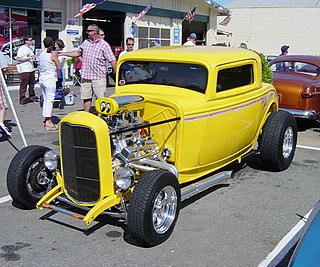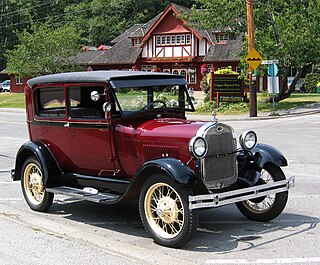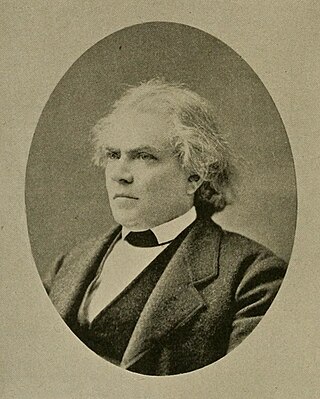
The National Street Rod Association or NSRA is an organization that hosts a number of hot rod and muscle car shows in the United States.

The National Street Rod Association or NSRA is an organization that hosts a number of hot rod and muscle car shows in the United States.
The editors of Rod and Custom magazine joined with street-rod clubs across the country to organize the first Street Rod Nationals in Peoria, Illinois, in August 1970, leading to the formation of the NSRA. [1] The NSRA was established as a privately owned corporation based in California. [2] Dick Wells was the first president and CEO. [3] Wells was a partner with Ray Brock in Rod Action, a street-rod publishing venture, and set up the NSRA headquarters office in the magazine's business suite. [2]
By 1973, Wells had set up thirty volunteer state representatives who advised the NSRA headquarters of regulatory developments, and also engaged with local officials and attended public hearings. Impressed by the effectiveness of that system, Specialty Equipment Market Association (SEMA) adopted it in 1975, and also hired Wells away from the NSRA. [3]
The NSRA held firmly to the stance that street rods were strictly vehicles with bodies from 1948 and earlier. As some enthusiasts pushed to include early 1950s vehicles, the NSRA added a street-machine division and added street-machine-only events. [2] In 2010, the NSRA changed its rules to admit cars that are at least 30 years old. [1]
The shows that are put on by the NSRA are:

Drag racing is a type of motor racing in which automobiles or motorcycles compete, usually two at a time, to be first to cross a set finish line. The race follows a short, straight course from a standing start over a measured distance, most commonly 1⁄4 mi, with a shorter, 1,000 ft distance becoming increasingly popular, as it has become the standard for Top Fuel dragsters and Funny Cars, where some major bracket races and other sanctioning bodies have adopted it as the standard. The 1⁄8 mi is also popular in some circles. Electronic timing and speed sensing systems have been used to record race results since the 1960s.

The Ford Model T is an automobile that was produced by the Ford Motor Company from October 1, 1908, to May 26, 1927. It is generally regarded as the first mass-affordable automobile, which made car travel available to middle-class Americans. The relatively low price was partly the result of Ford's efficient fabrication, including assembly line production instead of individual handcrafting. The savings from mass production allowed the price to decline from $780 in 1910 to $290 in 1924. It was mainly designed by three engineers, Joseph A. Galamb, Eugene Farkas, and Childe Harold Wills. The Model T was colloquially known as the "Tin Lizzie".

A railroad car, railcar, railway wagon, railway carriage, railway truck, railwagon, railcarriage or railtruck, also called a train car, train wagon, train carriage or train truck, is a vehicle used for the carrying of cargo or passengers on a rail transport network. Such cars, when coupled together and hauled by one or more locomotives, form a train. Alternatively, some passenger cars are self-propelled in which case they may be either single railcars or make up multiple units.

A lowrider or low rider is a customized car with a lowered body that emerged among Mexican American youth in the 1940s. Lowrider also refers to the driver of the car and their participation in lowrider car clubs, which remain a part of Chicano culture and have since expanded internationally. These customized vehicles are also artworks, generally being painted with intricate, colorful designs, unique aesthetic features, and rolling on wire-spoke wheels with whitewall tires.
In physics or engineering education, a Fermi problem, also known as a order-of-magnitude problem, is an estimation problem designed to teach dimensional analysis or approximation of extreme scientific calculations. Fermi problems are usually back-of-the-envelope calculations. The estimation technique is named after physicist Enrico Fermi as he was known for his ability to make good approximate calculations with little or no actual data. Fermi problems typically involve making justified guesses about quantities and their variance or lower and upper bounds. In some cases, order-of-magnitude estimates can also be derived using dimensional analysis.

Hot rods are typically American cars that might be old, classic, or modern and that have been rebuilt or modified with large engines optimized for speed and acceleration. One definition is: "a car that's been stripped down, souped up and made to go much faster." However, there is no definition of the term that is universally accepted and the term is attached to a wide range of vehicles. Most often they are individually designed and constructed using components from many makes of old or new cars, and are most prevalent in the United States and Canada. Many are intended for exhibition rather than for racing or everyday driving.

MotorTrend is an American automobile magazine. It first appeared in September 1949, and designated the first Car of the Year, also in 1949.

Bōsōzoku is a Japanese youth subculture associated with customized motorcycles. The first appearance of these types of biker gangs was in the 1950s. Popularity climbed throughout the 1980s, peaking at an estimated 42,510 members in 1982. Their numbers dropped dramatically in the 2000s, with fewer than 7,297 members in 2012. Later, in 2020, a Bōsōzoku rally that used to attract thousands of members only had 53 members, with police stating that it was a long time since they had to round up that many people.

A wrecking yard, scrapyard or junkyard is the location of a business in dismantling where wrecked or decommissioned vehicles are brought, their usable parts are sold for use in operating vehicles, while the unusable metal parts, known as scrap metal parts, are sold to metal-recycling companies. Other terms include wreck yard, wrecker's yard, salvage yard, breaker's yard, dismantler and scrapheap. In the United Kingdom, car salvage yards are known as car breakers, while motorcycle salvage yards are known as bike breakers. In Australia, they are often referred to as 'Wreckers'.

Cruising is a social activity that primarily consists of driving a car. Cruising is distinguished from regular driving by the social and recreational nature of the activity, which is characterized by an impulsively random, often aimless course. A popular route is often the focus of cruising. Cruising can be an expression of the freedom of possessing a driver's license. "Cruise nights" are evenings during which cars drive slowly.

The Ford Model A is the Ford Motor Company's second market success, replacing the venerable Model T which had been produced for 18 years. It was first produced on October 20, 1927, but not introduced until December 2. This new Model A was designated a 1928 model and was available in four standard colors.
The Street Rod Nationals is the world's largest street rod gathering. It is hosted annually by the NSRA. The Street Rod Nationals was first held in 1970 in Illinois and is currently held in Louisville, Kentucky. It has historically been held in a number of cities across the United States such as Columbus, Ohio and Memphis, Tennessee.
Robert Einar "Pete" Petersen was an American publisher who founded the Petersen Automotive Museum in 1994.

The Goodguys Rod & Custom Association is the largest association in the U.S. catering to street rods, custom cars and show cars. The Goodguys Association has over 70,000 active members worldwide. Goodguys stages 20 annual rod & custom car show events throughout the United States as well as vintage drag races.
Edward Dean Jeffries was an American custom car designer and fabricator, as well as stuntman and stunt coordinator for motion pictures and television programs based in Los Angeles, California.

John G. Stephenson, an American coachbuilder, invented and patented the first streetcar to run on rails in the United States. Stephenson also designed the New York and Harlem Railroad which was formally opened on 26 November 1832. Twelve days later a horse-drawn streetcar built at Stephenson's works and named John Mason after the president of the railroad company, started the public service. Stephenson is therefore remembered as the creator of the tramway. Stephenson was the great-grandfather of Alan Stephenson Boyd, the first United States Secretary of Transportation.

1950s American automobile culture has had an enduring influence on the culture of the United States, as reflected in popular music, major trends from the 1950s and mainstream acceptance of the "hot rod" culture. The American manufacturing economy switched from producing war-related items to consumer goods at the end of World War II, and by the end of the 1950s, one in six working Americans were employed either directly or indirectly in the automotive industry. The United States became the world's largest manufacturer of automobiles, and Henry Ford's goal of 30 years earlier—that any man with a good job should be able to afford an automobile—was achieved. A new generation of service businesses focusing on customers with their automobiles came into being during the decade, including drive-through or drive-in restaurants and greatly increasing numbers of drive-in theaters (cinemas).
Santa Ana Drags was the first drag strip in the United States. The strip was founded by C.J. "Pappy" Hart, Creighton Hunter and Frank Stillwell at the Orange County Airport auxiliary runway in southern California and was operational from June 19, 1950 until June 21, 1959

The Grand National Roadster Show, is a showcase of custom cars and hot rods held each year at the Fairplex in Pomona, California, in either late January or early February.

A dragster is a specialized competition automobile used in drag racing.